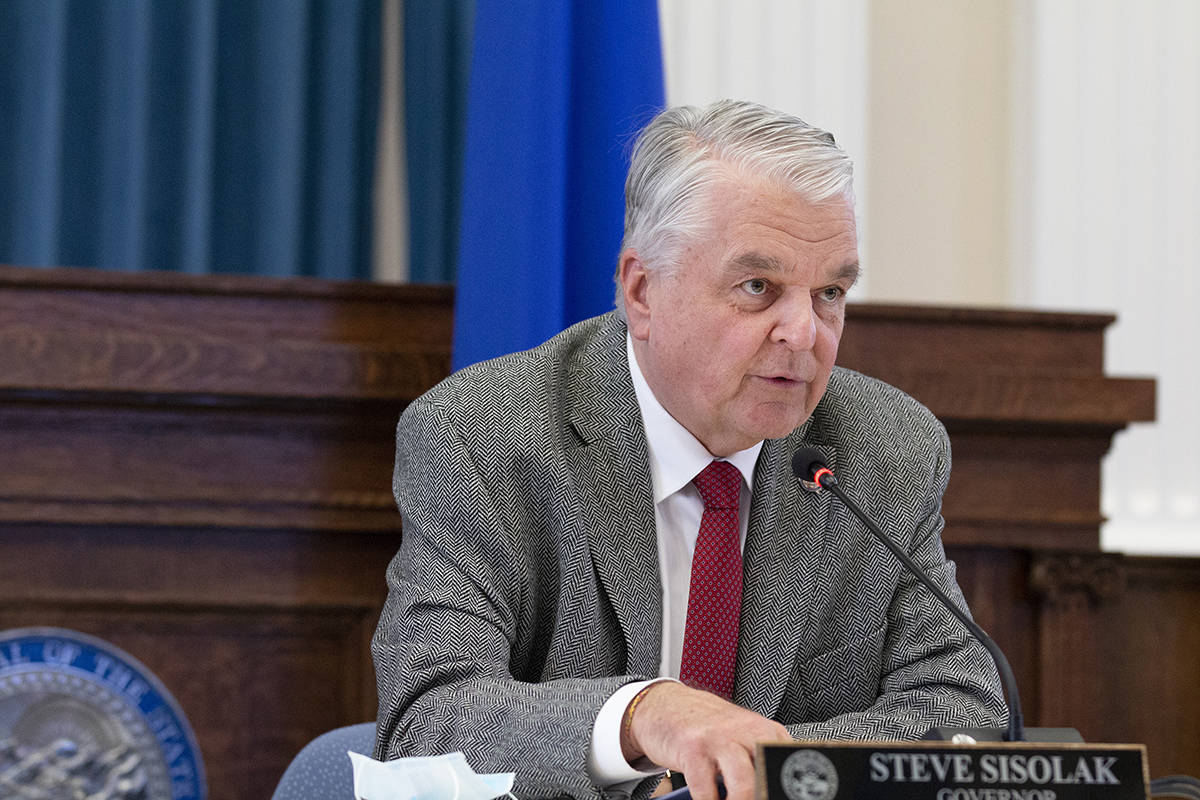Sisolak’s state budget shrinks slightly due to COVID-19
CARSON CITY — State spending over the next two years would shrink by 2 percent under Gov. Steve Sisolak’s proposed biennium budget, a reflection of the coronavirus pandemic’s fiscal impact roughly 10 months after the first Nevada cases appeared.
The reduction, however, is far less than was feared at the height of the economic shutdown that gripped the state at mid-2020, and significant areas of spending for health and education have been preserved or restored with no additional taxes proposed.
The governor’s budget for the two-year cycle that starts in July “recognizes the emergency we are experiencing as a result of the COVID-19 pandemic while also setting forth a clear plan to revitalize, innovate and grow Nevada’s economy,” Sisolak said in a statement with the release of his budget highlights.
Sisolak said he is “committed to remaining flexible and working closely with the Legislature in this unprecedented and evolving fiscal situation,” and he stressed that his proposed budget focuses on recovery from the crisis, job creation, education, criminal justice reform and protection of Nevadans’ health.
The proposed general fund budget of nearly $8.7 billion is $187 million less than the current plan, amended in special session last year in response to a $1.2 billion budget impact from the pandemic. The overall state budget, including money received from the federal government and other sources, tops $27 billion, an increase of 5.1 percent.
Senate Minority Leader James Settelmeyer, R-Minden, said Monday that he had only had a chance to skim the proposals, but he said he had concerns about whether the budget is overestimating the state’s economic strength amid continued COVID-19 restrictions on businesses.
“I think that’s incredibly optimistic and may not be realistic,” Settelmeyer said, adding that he’s concerned that the budget may be too reliant on federal relief funds. Settelmeyer said he would rather see those funds used to backfill holes rather than be part of the budget’s framework.
Senate Majority Leader Nicole Cannizzaro, D-Las Vegas, echoed the governor’s comments, saying in a statement that Sisolak’s recommended budget “recognizes the stark reality of the ongoing COVID-19 emergency while also laying the groundwork for Nevada’s economic recovery.”
Budget breakdown
Of that total budget, $15.2 billion is for health and human services, an increase of $2.6 billion over the current biennium. Medicaid costs, which account for two-thirds of that budget, are up nearly $1.6 billion.
The state’s Medicaid caseload has increased 18.7 percent over 2019 projections, with 761,000 Nevadans now covered, compared with 641,000 projected in 2019.
Nearly 1 in 4 Nevadans is currently enrolled in Medicaid, and the governor’s office expects that total to increase over the next two years to 778,000.
The budget includes $342 million in supplemental appropriations for the current fiscal year, the largest of which is $331 million for K-12 education to offset state and local revenue shortfalls caused by the pandemic.
Education for the 2021-23 biennium for both K-12 and higher education is budgeted at $7 billion, a decrease of $130 million over the current biennium.
K-12 will see a $30 million reduction and higher ed an $80 million reduction. The total K-12 expense is $6.6 billion, including $4.9 billion in state funds. Higher education funding is projected at $2 billion.
Those education budgets are expected to be augmented by federal dollars, both from the bill passed in December and by President-elect Joe Biden’s proposed stimulus.
Under the federal stimulus bill passed last month, K-12 education will receive $450 million in answer to pandemic-caused learning deficiencies and infrastructure and technology needs. Higher ed is expected to receive over $100 million in federal aid for lost revenue and costs related to distance learning and financial aid.
In addition, the president-elect’s pandemic stimulus plan would send a further $175 billion to schools nationally.
“That’s going to be one of the keys to getting Nevada back on its feet,” Sisolak chief of staff Michelle White told reporters in a budget briefing Monday. “That is going to be so instrumental in restoring some of the reductions that have had to take place, and also getting our kids back to in-person learning.”
Other highlights
The state is drawing on $97.5 million from its rainy day fund to offset budget cuts.
Other highlights by area of spending:
Education: One of the most significant changes to education in Sisolak’s budget comes in a proposed tweak to the implementation of the state’s new K-12 funding formula passed in 2019 under Senate Bill 543.
The bill, also called the Pupil-centered Funding Formula, is designed to give large urban districts with more challenging student populations more money while freezing rural districts at current funding for a time. The new formula was supposed to go into effect for the 2021-22 school year.
Sisolak’s budget proposes a phased-in approach, with the goal of allowing school districts to manage their resources without upending things entirely amid the pandemic and the related economic pinch.
The phased approach would start in fiscal year 2021, which starts July 1, with only state funds going through the new formula for two years, followed by full implementation with state and local revenues starting in 2023.
Additional highlights for the education budgets include 2 percent merit pay increases for K-12 teachers for each year of the budget, at a cost of $59.1 million for fiscal year 2022 and $119.5 million for fiscal year 2023; and $24 million per year for higher education to fund the 4.9 percent growth in weighted student credit hours.
Health and human services: Restoration of 6 percent Medicaid provider rate reductions, which were approved in special session last summer, in addition to $143.8 million more in general funds for medical inflation. Nearly $300 million over two years is set aside for Medicaid caseload growth.
Capital improvements: $416 million for 91 projects, including restored funding for a previously approved engineering and academic research building at the University of Nevada, Las Vegas.
One-time expenditures: $226.5 million to various agencies to be spent this year on projects that support business, health care workers, education scholarships, maintenance, technology and more. These expenditures include $25 million for the UNLV medical school, $44 million for Millennium scholarships, $6 million for testing and treating state prison inmates for hepatitis C and $78.7 million for various information technology projects.
State employees: Worker furloughs implemented starting this month will not continue next year. Retirement benefits for public employees will see a slight increase.
Contact Capital Bureau Chief Colton Lochhead at clochhead@reviewjournal.com. Follow @ColtonLochhead on Twitter. Contact Capital Bureau reporter Bill Dentzer at bdentzer@reviewjournal.com. Follow @DentzerNews on Twitter.
























